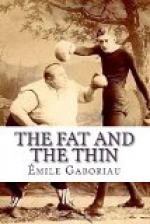This colouring-matter—“raucourt,” as the Parisians call it is used to give the butter a fine yellow tint. The butter women imagine that its composition is known only to themselves, and keep it very secret. However, it is merely made from anotta;[*] though a composition of carrots and marigold is at times substituted for it.
[*] Anotta, which is obtained from the pulp surrounding the seeds of the Bixa Orellana, is used for a good many purposes besides the colouring of butter and cheese. It frequently enters into the composition of chocolate, and is employed to dye nankeen. Police court proceedings have also shown that it is well known to the London milkmen, who are in the habit of adding water to their merchandise. —Translator.
“Come, do be quick!” La Sarriette now exclaimed, for she was getting impatient, and was, moreover, no longer accustomed to the malodorous atmosphere of the cellar. “Mademoiselle Saget will be going. I fancy she’s got something very important to tell you abut my uncle Gavard.”
On hearing this, Madame Lecoeur abruptly ceased working. She at once abandoned both butter and dye, and did not even wait to wipe her arms. With a slight tap of her hand she settled her cap on her head again, and made her way up the steps, at her niece’s heels, anxiously repeating: “Do you really think that she’ll have gone away?”
She was reassured, however, on catching sight of Mademoiselle Saget amidst the cheeses. The old maid had taken good care not to go away before Madame Lecoeur’s arrival. The three women seated themselves at the far end of the stall, crowding closely together, and their faces almost touching one another. Mademoiselle Saget remained silent for two long minutes, and then, seeing that the others were burning with curiosity, she began, in her shrill voice: “You know that Florent! Well, I can tell you now where he comes from.”
For another moment she kept them in suspense; and then, in a deep, melodramatic voice, she said: “He comes from the galleys!”
The cheeses were reeking around the three women. On the two shelves at the far end of the stall were huge masses of butter: Brittany butters overflowing from baskets; Normandy butters, wrapped in canvas, and resembling models of stomachs over which some sculptor had thrown damp cloths to keep them from drying; while other great blocks had been cut into, fashioned into perpendicular rocky masses full of crevasses and valleys, and resembling fallen mountain crests gilded by the pale sun of an autumn evening.
Beneath the stall show-table, formed of a slab of red marble veined with grey, baskets of eggs gleamed with a chalky whiteness; while on layers of straw in boxes were Bondons, placed end to end, and Gournays, arranged like medals, forming darker patches tinted with green. But it was upon the table that the cheeses appeared in greatest profusion. Here, by the side of the pound-rolls of butter lying on white-beet




